To see medieval splendour at Nidaros Domkirke

Nidaros Cathedral is Scandinavia's greatest medieval edifice and Europe's northernmost Gothic construction. Outside, the ornately decorated, altar-like west wall is adorned with top-to-bottom statues of biblical characters as well as Norwegian bishops and monarchs carved in the early twentieth century. Several are reproductions of medieval originals that are currently kept at the nearby museum. In stark contrast to the internal darkness, notice the brilliant, vibrant colors of the new stained glass in the rose window at the west end.
The altar is built on top of the actual burial of St Olav, the Viking monarch who converted the pagan Nordic faith to Christianity. When Norway formed a separate archbishopric in 1153, the initial stone cathedral was completed. The existing transept and chapter house were built between 1130 and 1180 and show Anglo-Norman elements (many artisans were brought in from England), while the Gothic choir and ambulatory were finished in the early 14th century. The nave, which has been periodically destroyed by fire throughout the years, is essentially a realistic 19th-century replacement.
An exhibit of medieval carved tombstones may be seen in the crypt (the majority restored from fragments since many headstones were broken up and carted away to be recycled in domestic buildings). Look for one engraved in English and dedicated to William Miller, Shipmaster of Dundee, Scotland, who died in the 18th century near Trondheim. You may explore on your own, but from early June and early August, it's recommended taking a tour (a 15-minute canter or a more detailed 45-minute visit). Music aficionados might plan their visit to coincide with a concert on the church's superb (and freshly refurbished) organ.
From mid-June to mid-August, you may climb the 172 steps up the cathedral's tower (50kr) for a beautiful perspective of the city, but keep in mind that the staircase is incredibly narrow and steep - and once you're on your way, there's practically no turning back past other tour-goers. Every half-hour, guided ascents leave from its base in the south transept, with a maximum of 20 persons each ascent.







